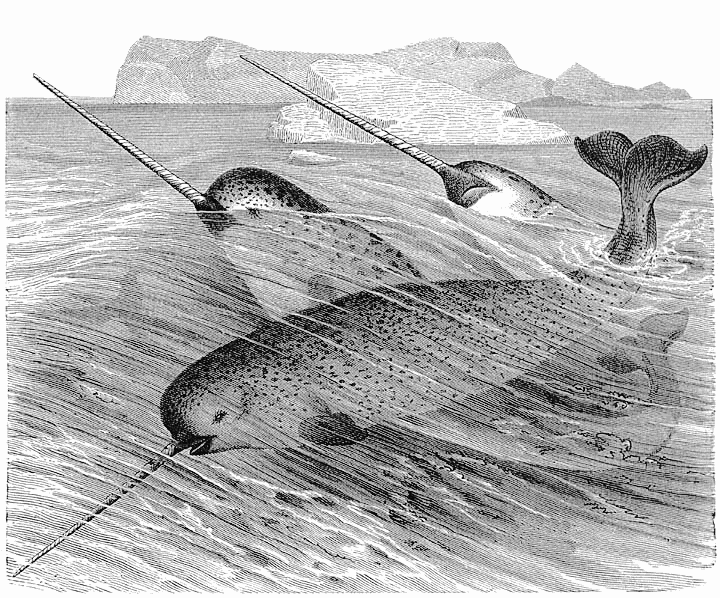The ecology of fear is a hypothesis that predators drive habitat use and behavior in prey species. In the Arctic, the orca drives behavioral changes in a variety of species including narwhals. Analyzing a narwhal population in a Fjord in Greenland researchers were able to look at how fear drives narwhal behavior.
Article
Breed, Greg A., Cory JD Matthews, Marianne Marcoux, Jeff W. Higdon, Bernard LeBlanc, Stephen D. Petersen, Jack Orr, Natalie R. Reinhart, and Steven H. Ferguson. “Sustained disruption of narwhal habitat use and behavior in the presence of Arctic killer whales.” Proceedings of the National Academy of Sciences 114, no. 10 (2017): 2628-2633.
Background
There was a seminar series for all biology majors to take at the university where I completed my undergraduate degree that included lectures on medicinal research, scientific communication, environmental policy, and a variety of other topics. As a budding ecologist, one lecture really resonated with me: Dr. Joel Brown, a professor from the University of Illinois-Chicago, spoke with us about his research testing a hypothesis he termed “the ecology of fear,” or predator-mediated behavior. Broadly, the hypothesis stated that everything from population dynamics to an individual organism’s energy budget is influenced by predators.
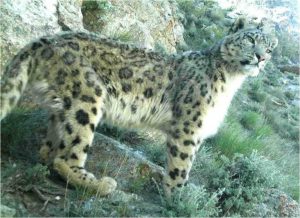
The lecture I saw followed recent research on the Himalayan tahr (Hemitragus jemlahicus), a goat-like species, and the impacts of the snow leopard (Panthera uncia) on the tahr’s movements. Most fascinating was a statement made that “within an hour of observing tahr behavior, the researcher could identify if a snow leopard was in the same Himalayan valley and roughly where in the valley it was.” That statement really stuck with me as a developing ecologist.
The idea of fear as a motivator for habitat use in prey is not new. One of the most famous examples of the ecology of fear involves changes in elk (Cervus candensis) behavior following the removal and reintroduction of gray wolves (Canis lupus) to Yellowstone National Park. While there are many terrestrial studies on the ecology of fear, this hypothesis has become more prevalent in studies of marine organisms in the previous two decades. Research in Shark Bay, Australia has examined the long-term impacts of tiger sharks (Galeocerdo cuvier) on sea grass communities, while changes in predator densities near coral reef communities have been studied for patterns of predator-mediated habitat use.
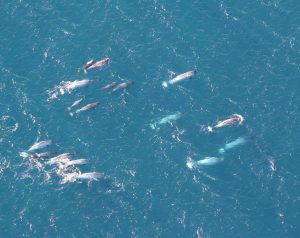
The ecology of fear is unique because it involves all species in a food web in one way or another. Spectacularly, in marine food webs this extends to some of the biggest animals on the planet. The narwhal (Monodon monceros) is a medium-sized, toothed whale that inhabits frigid Arctic waters. It has a long history of being referred to as the “unicorn of the sea” due to the modified left canine tooth that grows into a long, spiraling tusk, mostly on males. The orca (Orcinus orca), or killer whale, is the ocean’s top predator. Different orca populations are known to feed on bony fish, sharks, rays, birds, seals, dolphins, and whales. One estimate I found from Jefferson et al. (1991) discussed evidence of orca predation on 36 different species of marine mammals. The most widely distributed organism on the planet, the orca is one of the primary predators of narwhals, alongside polar bears (Ursus maritimus).

As the amount of sea ice in the Arctic declines, there is an increasing need to understand the ecological fallout. Researchers have already started to see increases in the amount of time that orcas and other top predators are spending in Arctic waters as temperatures warm. Warming temperatures are anticipated to continue in the Arctic, and will likely lead to increased interactions between these species. Studying the behavioral response and adaptability of narwhals to orca presence is necessary to understand how these changes impact narwhal predation risk.
Study Goals
The goal of this study was to investigate the impact of orcas on narwhal ecology by tagging several individuals from each species in Admiralty Inlet near Baffin Bay, Greenland (see Fig 1). Due to the interconnected relationships of orca pods or a group of orcas, only one individual was tagged and assumed to represent the movements of a pod consisting of roughly 12-20 individuals. Because narwhals groups are not typically as cohesive as orca pods, seven narwhals were tagged and tracked. Narwhals and orcas used Admiralty Inlet concurrently for 10 days before the orcas left, allowing for the study to investigate narwhal behavior with and without orcas present.
Findings
When orcas were present in Admiralty Inlet, narwhals exclusively used the habitat near shore (see Fig. 4). In fact, the most frequently used habitat was within 500 meters (1640 ft.) of shore and interestingly, narwhal diving patterns mirrored this trend with narwhals preferring to dive less than 100 meters (330 feet) and cut their dives short by 25 seconds on average when exposed to orcas. For comparison, when orcas left Admiralty Inlet, narwhals tended to use habitats 4-10 kilometers (2.5 – 6.2 miles) from shore and dove less than 400 meters (1312 ft.) on average.
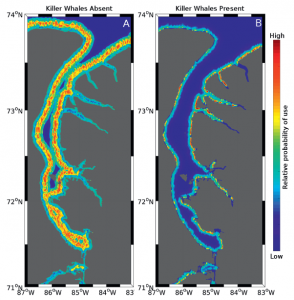
These observations show that narwhals make distinct changes in behavior to avoid orcas when they are present. To find out if the changes were caused by specific factors, the authors used a mixed effects model – a statistical method of testing individual and combined variables to see what drives behavioral changes. In most of the models, the presence of orcas in the environment was the strongest contributor to changes in narwhal behavior, with the overall distance between the two being a minor factor.
Predators are thought to exert two types of influences on prey species; consumptive (direct feeding) and nonconsumptive (behavioral changes). This study is unique because it provides the first analysis of nonconsumptive effects of predators on narwhals. Studying the nonconsumptive effects of predators on prey species is a daunting task, because it can include a variety of behavior changes in foraging, habitat use, reproduction, and energy expenditure. Regardless, monitoring nonconsumptive effects on species is crucial for proper management. Without investigating all of the impacts of predators on species like narwhals, it is easy conclude that habitats that provide shelter for prey are preferred for other reasons, such as feeding. Without simultaneous research on predators, it is difficult to separate normal behavior from predator-mediated changes.
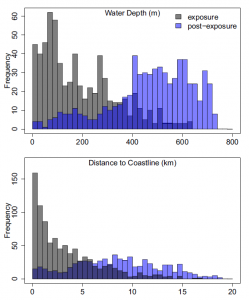
Understanding the impacts of concurrent habitat use in predators and prey in the Arctic has become a hot button issues for researchers. The authors noted that the amount of time that narwhals and orcas share in some areas is steadily increasing. Furthermore, in areas where orcas or other large predators such as sharks have seasonal movement patterns, an extended stay in a habitat can result in a cascade of ecosystem changes through nonconsumptive impacts.
Current global trends show water temperatures continuing to warm for several decades. Without understanding the full scale of predator-mediated food web dynamics, scientists and policy makers may be underestimating how to properly manage populations in this dynamic environment. If warming trends continue as predicted, it will be difficult to accommodate for the ecology of fear in Arctic ecosystems with increasing predator presence. Novel studies like this one will be necessary to determine how to best manage a rapidly changing Arctic.

